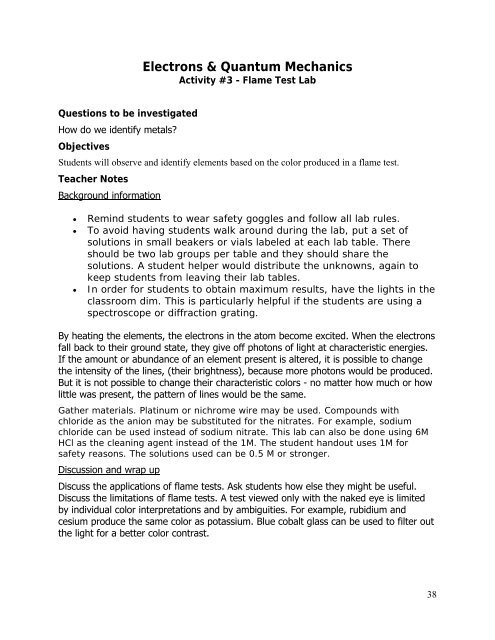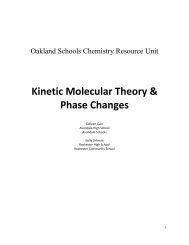Electrons and Quantum Mechanics - Oakland Schools
Electrons and Quantum Mechanics - Oakland Schools
Electrons and Quantum Mechanics - Oakland Schools
You also want an ePaper? Increase the reach of your titles
YUMPU automatically turns print PDFs into web optimized ePapers that Google loves.
<strong>Electrons</strong> & <strong>Quantum</strong> <strong>Mechanics</strong><br />
Activity #3 - Flame Test Lab<br />
Questions to be investigated<br />
How do we identify metals?<br />
Objectives<br />
Students will observe <strong>and</strong> identify elements based on the color produced in a flame test.<br />
Teacher Notes<br />
Background information<br />
• Remind students to wear safety goggles <strong>and</strong> follow all lab rules.<br />
• To avoid having students walk around during the lab, put a set of<br />
solutions in small beakers or vials labeled at each lab table. There<br />
should be two lab groups per table <strong>and</strong> they should share the<br />
solutions. A student helper would distribute the unknowns, again to<br />
keep students from leaving their lab tables.<br />
• In order for students to obtain maximum results, have the lights in the<br />
classroom dim. This is particularly helpful if the students are using a<br />
spectroscope or diffraction grating.<br />
By heating the elements, the electrons in the atom become excited. When the electrons<br />
fall back to their ground state, they give off photons of light at characteristic energies.<br />
If the amount or abundance of an element present is altered, it is possible to change<br />
the intensity of the lines, (their brightness), because more photons would be produced.<br />
But it is not possible to change their characteristic colors - no matter how much or how<br />
little was present, the pattern of lines would be the same.<br />
Gather materials. Platinum or nichrome wire may be used. Compounds with<br />
chloride as the anion may be substituted for the nitrates. For example, sodium<br />
chloride can be used instead of sodium nitrate. This lab can also be done using 6M<br />
HCl as the cleaning agent instead of the 1M. The student h<strong>and</strong>out uses 1M for<br />
safety reasons. The solutions used can be 0.5 M or stronger.<br />
Discussion <strong>and</strong> wrap up<br />
Discuss the applications of flame tests. Ask students how else they might be useful.<br />
Discuss the limitations of flame tests. A test viewed only with the naked eye is limited<br />
by individual color interpretations <strong>and</strong> by ambiguities. For example, rubidium <strong>and</strong><br />
cesium produce the same color as potassium. Blue cobalt glass can be used to filter out<br />
the light for a better color contrast.<br />
38
















